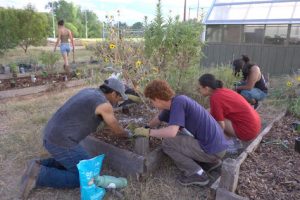UT Microfarm Helps Students Fight Food Insecurity, One Harvest at a Time
By Zach Cook
Reporting Texas

Volunteer Walker Moore and other farm members tend to a garden plot at UT’s Microfarm on Oct. 1, 2025. Zach Cook/Reporting Texas
Tucked away in The University of Texas’ East Campus, a small patch of farmland is growing more than just vegetables. It’s cultivating community.
Behind Whitaker Fields, rows of crops stretch under the Texas sun as students trade laptops for gardening gloves and shovels. At the UT Microfarm, getting hands dirty is part of a bigger picture to learn about sustainability and give back to others.
“The mission of the Microfarm is to provide a space for people to learn about sustainable agriculture, to build community, and to give back to that community,” said Ciera Kelley, co-leader of the UT Microfarm.
Students cultivate everything from leafy greens to root vegetables, and it’s all done in the middle of Austin’s urban sprawl. What’s harvested here goes straight to the UT Outpost, a student-run food pantry that helps Longhorns facing food insecurity.
“About 40 percent of UT students have faced some sort of food insecurity while being at UT,” said Caroline Wheir, volunteer coordinator at the UT Outpost.
Wheir explains how the term food insecurity holds more weight than some realize. Food insecurity isn’t only about uncertainty over the next meal, but also about the quality of the food available.
“People always joke about college students only eating ramen, part of that is because of how cheap ramen is,” Wheir said. “But for things like produce that might be a little more expensive than ramen, it’s great to know that they are still putting nourishing food into their body.”
Since 2019, every harvest from the Microfarm has been donated to the Outpost, contributing to more than 43 tons of food distributed last year alone.
“In terms of helping more students, it’s been steadily rising more and more as the years go by,” Wheir said. “We see about 500 students a week.”
For many students, the farm is a place to escape from campus stress and connect with something meaningful.
“There’s a lot of asphalt and concrete in my day-to-day life, and I wanted to get hands-on with some soil and plants and interact with life,” said Walker Moore, a Microfarm volunteer.
The work isn’t always easy. From bug bites to sweltering heat, volunteers face their fair share of challenges, but they say it’s worth every drop of sweat.
“Farm is gonna be farm, and it’s kind of wild and untameable,” Kelley said.
In a city built on concrete and never-ending construction, their facilities have become a hidden oasis. It’s a reminder that growth can happen anywhere, as long as people care enough to plant the seeds.
To learn how to volunteer or donate to the Microfarm or UT Outpost, visit utenvironment.org.